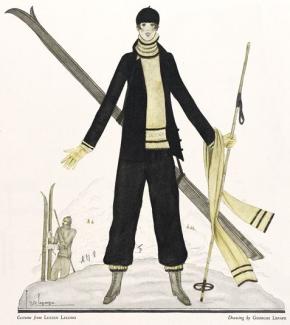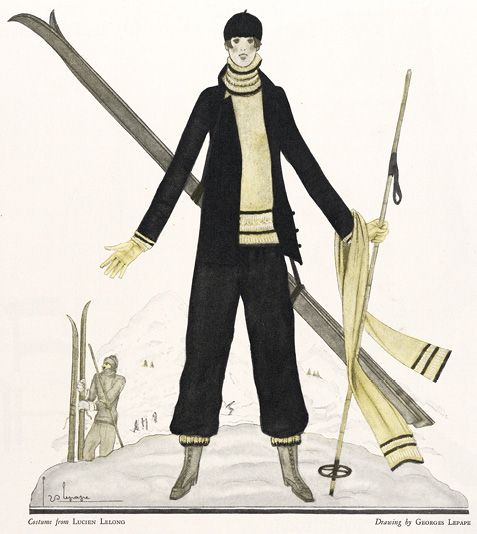Ski Art: Georges Lepape (1887-1971)

In 1911, French artist Georges Lepape created a limited edition of illustrations that depicted women wearing fashion designer Paul Poiret’s clothing and accessories. The work was entitled Les choses de Paul Poiret, and it had a major impact on the relationship between art and fashion—Lepape the artist, Poiret the designer.
In artistic terms, the period from the turn of the century to the beginning of World War I, in 1914, were the years of Art Nouveau. The French-inspired movement spread all over the world, with the German Jugendstil becoming the best-known iteration.
Accordingly, Lepape incorporated Eastern motifs and fine lines and color in his illustrations for books and their covers, playbills, magazines, textiles and fashion. He had learned some of this at the École des Beaux-Arts in Paris.
Poiret, meanwhile, had an uncanny sense in divining how the wealthier women of the world wished to look. He was simply “Le Magnifique” and, in America, the “King of Fashion.” His styles defined a lifestyle of active youth. “No one was allowed to be middle aged,” sighed Lady Troubridge in 1925, reflecting on the angst of the older generation.

The success of Lepape’s artwork depicting Poiret’s fashion brought him attention from the editors of upscale magazines in Paris and London, including Le Bon Ton, for which he created illustrations. In France he drew pictures advertising perfume companies Arys and d’Orsay, as well as Renault cars, Leroy furs and the big department stores of Paris, the Galleries Lafayette and Printemps.
In 1920, Lepape had his first major exhibition, at the Musée des Arts Décoratifs. Six years later, publisher Condé Nast invited him to New York. Between 1916 and 1939, he was the cover artist for 114 issues of Vogue while also contributing covers for Femina, Harper’s Bazaar, La Donna, Home and Garden and Vanity Fair.
This illustration is from the January 1928 issue of Woman’s Home Companion and was described as “rather Russian in appearance.” It showcases Lepape’s methods of portraying the youthful lifestyle as the subject wears a “costume from Lucien Lelong,” one of the top-ranked designers. The advertisement is not unlike a Femina cover of 1925.
Lepape’s son, Claude, also an artist, wrote about his father’s work in From the Ballets Russe to Vogue. The Art of Georges Lepape. —E. John B. Allen
